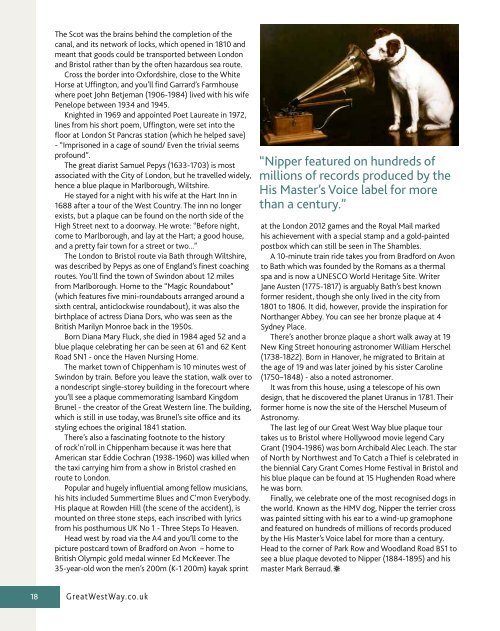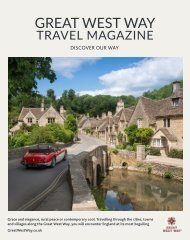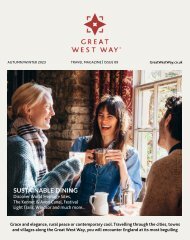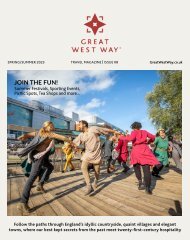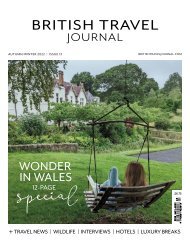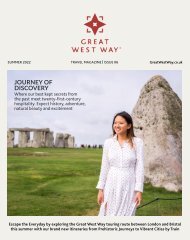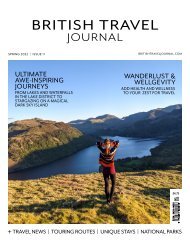Great West Way® Travel Magazine | Issue 01
The first edition of a brand-new magazine showcasing the Great West Way, Britain's newest touring route, has been launched. The Great West Way Travel Magazine features 84 pages of informative articles and stunning photography brimming with inspiration to explore further, delve deeper and uncover the essence of this unique part of England. It presents a series of inspirational themed features, articles and ideas suitable for visitors travelling along the route by road, rail, water, on bike or on foot. The magazine highlights the extraordinary variety of amazing tourism destinations and experiences along the route, each with something unique to offer. From idyllic countryside, beautifully quaint villages to elegant towns and buzzing cities, a route where creativity and culture rub shoulders with world-famous heritage.
The first edition of a brand-new magazine showcasing the Great West Way, Britain's newest touring route, has been launched. The Great West Way Travel Magazine features 84 pages of informative articles and stunning photography brimming with inspiration to explore further, delve deeper and uncover the essence of this unique part of England. It presents a series of inspirational themed features, articles and ideas suitable for visitors travelling along the route by road, rail, water, on bike or on foot. The magazine highlights the extraordinary variety of amazing tourism destinations and experiences along the route, each with something unique to offer. From idyllic countryside, beautifully quaint villages to elegant towns and buzzing cities, a route where creativity and culture rub shoulders with world-famous heritage.
Create successful ePaper yourself
Turn your PDF publications into a flip-book with our unique Google optimized e-Paper software.
The Scot was the brains behind the completion of the<br />
canal, and its network of locks, which opened in 1810 and<br />
meant that goods could be transported between London<br />
and Bristol rather than by the often hazardous sea route.<br />
Cross the border into Oxfordshire, close to the White<br />
Horse at Uffington, and you’ll find Garrard’s Farmhouse<br />
where poet John Betjeman (1906-1984) lived with his wife<br />
Penelope between 1934 and 1945.<br />
Knighted in 1969 and appointed Poet Laureate in 1972,<br />
lines from his short poem, Uffington, were set into the<br />
floor at London St Pancras station (which he helped save)<br />
- “Imprisoned in a cage of sound/ Even the trivial seems<br />
profound”.<br />
The great diarist Samuel Pepys (1633-1703) is most<br />
associated with the City of London, but he travelled widely,<br />
hence a blue plaque in Marlborough, Wiltshire.<br />
He stayed for a night with his wife at the Hart Inn in<br />
1688 after a tour of the <strong>West</strong> Country. The inn no longer<br />
exists, but a plaque can be found on the north side of the<br />
High Street next to a doorway. He wrote: “Before night,<br />
come to Marlborough, and lay at the Hart; a good house,<br />
and a pretty fair town for a street or two...”<br />
The London to Bristol route via Bath through Wiltshire,<br />
was described by Pepys as one of England’s finest coaching<br />
routes. You’ll find the town of Swindon about 12 miles<br />
from Marlborough. Home to the “Magic Roundabout”<br />
(which features five mini-roundabouts arranged around a<br />
sixth central, anticlockwise roundabout), it was also the<br />
birthplace of actress Diana Dors, who was seen as the<br />
British Marilyn Monroe back in the 1950s.<br />
Born Diana Mary Fluck, she died in 1984 aged 52 and a<br />
blue plaque celebrating her can be seen at 61 and 62 Kent<br />
Road SN1 - once the Haven Nursing Home.<br />
The market town of Chippenham is 10 minutes west of<br />
Swindon by train. Before you leave the station, walk over to<br />
a nondescript single-storey building in the forecourt where<br />
you’ll see a plaque commemorating Isambard Kingdom<br />
Brunel - the creator of the <strong>Great</strong> <strong>West</strong>ern line. The building,<br />
which is still in use today, was Brunel’s site office and its<br />
styling echoes the original 1841 station.<br />
There’s also a fascinating footnote to the history<br />
of rock’n’roll in Chippenham because it was here that<br />
American star Eddie Cochran (1938-1960) was killed when<br />
the taxi carrying him from a show in Bristol crashed en<br />
route to London.<br />
Popular and hugely influential among fellow musicians,<br />
his hits included Summertime Blues and C’mon Everybody.<br />
His plaque at Rowden Hill (the scene of the accident), is<br />
mounted on three stone steps, each inscribed with lyrics<br />
from his posthumous UK No 1 - Three Steps To Heaven.<br />
Head west by road via the A4 and you’ll come to the<br />
picture postcard town of Bradford on Avon – home to<br />
British Olympic gold medal winner Ed McKeever. The<br />
35-year-old won the men’s 200m (K-1 200m) kayak sprint<br />
“Nipper featured on hundreds of<br />
millions of records produced by the<br />
His Master’s Voice label for more<br />
than a century.”<br />
at the London 2<strong>01</strong>2 games and the Royal Mail marked<br />
his achievement with a special stamp and a gold-painted<br />
postbox which can still be seen in The Shambles.<br />
A 10-minute train ride takes you from Bradford on Avon<br />
to Bath which was founded by the Romans as a thermal<br />
spa and is now a UNESCO World Heritage Site. Writer<br />
Jane Austen (1775-1817) is arguably Bath’s best known<br />
former resident, though she only lived in the city from<br />
18<strong>01</strong> to 1806. It did, however, provide the inspiration for<br />
Northanger Abbey. You can see her bronze plaque at 4<br />
Sydney Place.<br />
There’s another bronze plaque a short walk away at 19<br />
New King Street honouring astronomer William Herschel<br />
(1738-1822). Born in Hanover, he migrated to Britain at<br />
the age of 19 and was later joined by his sister Caroline<br />
(1750–1848) - also a noted astronomer.<br />
It was from this house, using a telescope of his own<br />
design, that he discovered the planet Uranus in 1781. Their<br />
former home is now the site of the Herschel Museum of<br />
Astronomy.<br />
The last leg of our <strong>Great</strong> <strong>West</strong> Way blue plaque tour<br />
takes us to Bristol where Hollywood movie legend Cary<br />
Grant (1904-1986) was born Archibald Alec Leach. The star<br />
of North by Northwest and To Catch a Thief is celebrated in<br />
the biennial Cary Grant Comes Home Festival in Bristol and<br />
his blue plaque can be found at 15 Hughenden Road where<br />
he was born.<br />
Finally, we celebrate one of the most recognised dogs in<br />
the world. Known as the HMV dog, Nipper the terrier cross<br />
was painted sitting with his ear to a wind-up gramophone<br />
and featured on hundreds of millions of records produced<br />
by the His Master’s Voice label for more than a century.<br />
Head to the corner of Park Row and Woodland Road BS1 to<br />
see a blue plaque devoted to Nipper (1884-1895) and his<br />
master Mark Berraud.<br />
18 <strong>Great</strong><strong>West</strong>Way.co.uk


